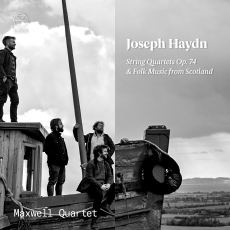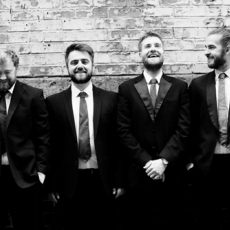Maxwell Quartet - Haydn: String Quartets Op. 74 - Folk Music from Scotland - Planet Hugill
The young Scottish quartet continues its engaging exploration of Haydn's later quartets, imaginatively paired with folk music from Scotland.
The Maxwell Quartet's previous disc on Linn Records combined Haydn's String Quartets Opus 71 with folk music from Scotland, and the quartet's new (released 8/1/2021) generously filled disc for Linn follows this up with Haydn's String Quartets Opus 74 and further folk music from Scotland, including music by Niel Gow, Nathaniel Gow, Isaac Cooper, William Marshall and Sine NicFhionnlaigh.
The two discs make a neat pairing because Haydn wrote his Opus 71 and Opus 74 quartets as a set of six, it was the publisher who split them up. The quartets arise directly from Haydn's changing circumstances. In 1790 his employer of nearly 30 years, Prince Nikolaus Esterházy, died and the Prince's successor drastically reduced the musical establishment. Haydn was now free and in 1791 he accepted an invitation from the impresario Johann Peter Salomon for a visit to London to perform his music at Salmon's concert series there.
Thanks to the music publishing industry Haydn was famous. He might have been marooned for much of the time in the Prince's palaces, but his music was published and disseminated, and since the late 1770 thanks to a revised contract with the Prince, Haydn could directly benefit from sales of his music. The visit to London had another effect on Haydn, he heard his quartets performed at public concerts. In Vienna, the string quartet was an intimate medium, played to a small group, but in London virtuoso instrumentalists played them to a public audience. So when the composer returned from London in 1792, he wrote his sequence of six quartets full of brilliance and energy, orchestral textures and dramatic effects.
The Maxwell Quartet say in the programme note that Haydn never went to Scotland, but of course he did have a relationship with Scottish music. During the late 18th century there was a movement to collect and publish Scottish folk-songs in versions suitable for performing in the parlour. Between 1791 and 1804 Haydn created hundreds of arrangements of folk songs for George Thomson, the Edinburgh folksong collector, and for other publishers in London and in Edinburgh.
The Scottish music on this disc arises from a mixture of anonymous melodies, and those directly connected to fiddler composer figures. Two figures were central to this re-discovery and re-purposing of Scots song, the fiddler and composer Niel Gow (1727-1807) and his son Nathaniel (1763-1831), who was a fiddler and music publisher, between 1799 and 1824 he published a significant number of collections of Scots tunes. So here we have a pair of their songs, and there are songs from other known names, Isaac Cooper of Banff (flourished 1783 to 1810) who published a book of his own tunes, and William Marshall of Fochabers (1748-1833), who wrote over 200 tunes and published two collections of his works. The final pairing is of a Scots Gaelic song by Sine NicFhionnlaigh with one that is anonymous. All the arrangements are by the Maxwell Quartet.
The Maxwell Quartet was formed in 2010 at the Royal Conservatoire of Scotland where the four original members were all postgraduate students and close friends. In 2014, the line-up change with a new first violin and viola, and the quartet has remained in this format since. From 2019 to 2021, they are Associate Artist at the Royal Conservatoire of Scotland and at the Music at Paxton festival.
Each of Haydn's quartets in this set begins with a pay-attention type gesture, something that he used in his symphonies written for public concerts in London. The quartet are traditional in construction, but full of imaginative details and movements often never quite go where you are expecting. The Maxwell Quartet make the opening Allegro of No. 1 lively and stylish, throughout the disc their playing is full of character and there is a distinctive quality to their string tone which perhaps hints at HIP elements. The Andantino is surprisingly perky, full of interesting details, followed by a crisp Menuetto with dance elements to the fore and then a fast finale full of tight rhythms. This vivid movement is one of those that never quite goes where you expect. The players also bring out the classicism of this music, showing the way Haydn keeps his wit and imagination within bounds.
The second quartet begins with a positively toe-tapping movement, for all their complexity and imagination there is also a crowd-pleasing element to these quartets. The following theme and variations is graceful with Haydn introducing plenty of imaginative touches in the variations, and the Menutto is definitely on the robust side. In the Presto finale, Haydn's use of rhythm gives the movement a terrific sense of forward motion.
The third quartet starts with a movement which has two very contrasting subjects. The booklet notes talk about the first subject being Sturm und Drang, but the players give it a very misterioso feel which leads aptly into the elegant dance of the second subject. The touching Largo assai is elegant too, intense and intimate. With the Menuetto we are definitely in country dance territory for all the music's elegance, and the finale, Allegro con brio is full of robust character.
For the Scottish traditional music, the quartet bring together two (or three) contrasting tunes, moving from slow to fast. The quartet's own arrangements definitely bring this music into the salon, but the plangent solo fiddle in the Gow's Coilsfield House suggests traditional fiddle playing whilst Dry in the Morning is a lively yet elegant dance. Sine NicFhionnlaigh's Fear a'Bhata brings Gaelic melancholy right into the drawing room and contrasts with the lively reel, Da Full Rigged Ship/Da New Rigged Ship. The final group of three, moves from the anonymous The Burning of the Piper's Hut, an evocative dance, to the more robust The Marquis of Huntleyby William Marshall and then the busy textures of the up tempo Miss Gordon of Gight by Isaac Cooper, all three keeping the toes tapping.
Whether playing Haydn or folk music arrangements, the playing from the quartet is never less than vividly communicative and stylishly engaged, and this disc certainly made me want to look up their earlier recording of Haydn's Opus 71 quartets. And I do hope they continue their exploration of late Haydn quartets, after all there are the still the six Opus 76 and the two Opus 77 quartets!

